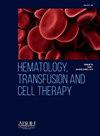CONGENITAL DYSERYTHROPOIETIC ANEMIA TYPE I: PATIENT WITH ANEMIA AND SKELETAL ANOMALY
IF 1.8
Q3 HEMATOLOGY
引用次数: 0
Abstract
Objective
Congenital dyserythropoietic anemias (CDAs) are inherited anemias that affect the erythroid lineage. CDAs are classified into the 3 major types (I, II, III) according to morphological, clinical and genetic features. (1) Before genetic diagnostic methods, bone marrow morphological abnormalities were the key diagnostic features of CDAs, such as erythroid hyperplasia with thin internuclear chromatin bridges between erythroblasts, binuclearity or multinuclearity of erythroblasts.(2) Next generation sequencing (NGS) has revolutionized the field of diagnosis. CDA type I (CDAI) is characterized by severe or moderate anemia and congenital anomalies such as skeletal abnormalities, chest deformity and short stature with identification of biallelic pathogenic variants in CDAN1 or CDIN1. (3) The standard clinical management of CDA patients is measurement of hemoglobin and iron, transferrin saturation and serum ferritin concentration to monitor iron overload every three to six months.
Case report
28 year old female patient presented to our clinic with normocytic anemia (hb: 6,50 g/dL), splenomegaly, short stature, limb and vertebral deformities. Clinically, the patient was evaluated for anemia. All routine blood investigations were done (Table 1). Bone marrow biopsy showed hypercellularity for age with increased rate in the erythroid series with marked dysmorphism findings. (figure 1) Next-generation sequencing was performed for diagnosis in the patient with dyserythropoiesis and morphological anomaly. Homozygous variant of CDIN1 gene was detected. Detailed NGS and karyotype analysis of the patient are shown in table 2 and 3. The patient diagnosed with congenital dyserythropoietic anemia type 1 and followed up with deferasirox and erythrocyte replacement.
Conclusion
CDAs are characterized by clinical and genetic heterogeneities. NGS based testing allows diagnosis. The increased knowledge of the genetic features and the detailed phenotyping of these patients will allow for the earliest start of the necessary treatment for the affected patients, as well as the monitoring of hemoglobin and iron levels. References:(1) Iolascon A, Andolfo I, Russo R. Congenital dyserythropoietic anemias. Blood. 2020 Sep 10;136(11):1274-1283. doi: 10.1182/blood.2019000948. PMID: 32702750. (2) Roy NBA, Babbs C. The pathogenesis, diagnosis and management of CDA type I. Br J Haematol. 2019. doi: 10.1111/bjh.15817. (3) Heimpel H, Kellermann K, Neuschwander N, Högel J, Schwarz K. The morphological diagnosis of congenital dyserythropoietic anemia: results of a quantitative analysis of peripheral blood and bone marrow cells. Haematologica. 2010;95(6):1034-1036
求助全文
约1分钟内获得全文
求助全文
来源期刊

Hematology, Transfusion and Cell Therapy
Multiple-
CiteScore
2.40
自引率
4.80%
发文量
1419
审稿时长
30 weeks
 求助内容:
求助内容: 应助结果提醒方式:
应助结果提醒方式:


